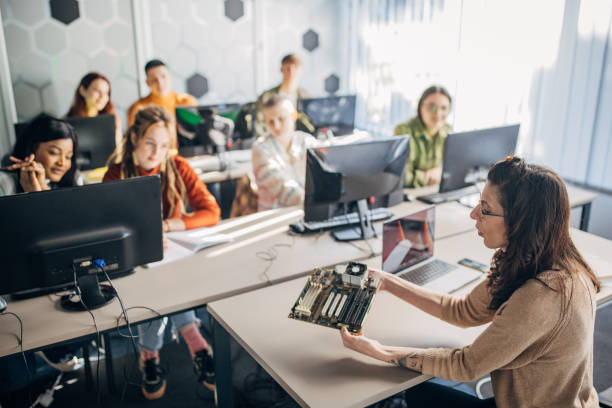Educational technology, often referred to as EdTech, encompasses a wide range of tools and practices designed to enhance teaching and learning experiences. As digital advancements continue to shape various aspects of society, the integration of technology in education has become increasingly vital. This article explores the evolution of educational technology, its benefits and challenges, and its impact on modern education.

The Evolution of Educational Technology
- Early Beginnings:
- Radio and Television: The use of radio and television in education marked the initial phase of EdTech, providing students with access to educational programs and lectures beyond the traditional classroom setting.
- Computers and Software: The advent of personal computers in the 1980s brought about significant changes. Educational software and CD-ROMs became popular, offering interactive learning experiences and access to digital content.
- The Internet Era:
- Online Learning Platforms: The rise of the internet in the 1990s and 2000s revolutionized education. Online learning platforms, such as Khan Academy and Coursera, emerged, providing learners with access to a vast array of courses and resources from anywhere in the world.
- Digital Classrooms: The integration of digital tools like interactive whiteboards, projectors, and learning management systems (LMS) facilitated the creation of digital classrooms, where teachers could deliver multimedia-rich lessons and manage course materials online.
- Mobile and Cloud Technologies:
- Smart Devices: The proliferation of smartphones and tablets enabled mobile learning, allowing students to access educational content on-the-go. Apps and e-books made learning more flexible and accessible.
- Cloud Computing: Cloud-based services provided a platform for collaborative learning and storage of educational resources. Tools like Google Classroom and Microsoft Teams streamlined communication and resource sharing between teachers and students.

- Emerging Technologies:
- Artificial Intelligence (AI): AI-powered tools, such as adaptive learning platforms and chatbots, offer personalized learning experiences by analyzing student data and adjusting content to meet individual needs.
- Virtual and Augmented Reality (VR/AR): VR and AR technologies create immersive learning environments, allowing students to explore virtual worlds, conduct experiments, and visualize complex concepts.
Benefits of Educational Technology
- Enhanced Engagement and Motivation:
- Interactive Learning: EdTech tools like gamified learning platforms, simulations, and interactive videos make learning more engaging and enjoyable. These tools capture students’ attention and motivate them to participate actively in their education.
- Multimedia Resources: The use of multimedia elements, such as videos, animations, and audio, caters to different learning styles and helps students understand and retain information more effectively.
- Personalized Learning:
- Adaptive Learning: AI-powered platforms can analyze student performance and adapt content to address individual strengths and weaknesses. This personalized approach ensures that each student receives the support they need to succeed.
- Flexible Pacing: Online courses and digital resources allow students to learn at their own pace, accommodating different learning speeds and schedules. This flexibility is particularly beneficial for adult learners and those with busy lifestyles.
- Collaboration and Communication:
- Collaborative Tools: EdTech platforms like Google Docs, Slack, and Padlet facilitate collaboration among students, allowing them to work together on projects and assignments in real-time, regardless of their physical location.
- Global Connectivity: Technology connects students and educators from around the world, fostering cultural exchange and global perspectives. Virtual exchange programs and online forums enable students to interact and learn from diverse peers.
- Access to Resources:
- Digital Libraries: Online libraries and databases provide students with access to a vast array of academic resources, including journals, e-books, and research papers, enhancing their research capabilities.
- Open Educational Resources (OER): OER platforms offer free and openly licensed educational materials, making high-quality content accessible to all learners, regardless of their financial background.
Challenges of Educational Technology
- Digital Divide:
- Access Inequality: Not all students have equal access to technology and the internet. The digital divide can exacerbate educational inequalities, leaving some students at a disadvantage.
- Infrastructure Limitations: Inadequate infrastructure, such as unreliable internet connectivity and outdated devices, can hinder the effective implementation of EdTech in certain regions.

- Teacher Training and Support:
- Professional Development: Educators need adequate training and ongoing support to effectively integrate technology into their teaching practices. Without proper training, teachers may struggle to utilize EdTech tools to their full potential.
- Resistance to Change: Some educators may resist adopting new technologies due to a lack of familiarity or comfort with digital tools. Addressing this resistance requires comprehensive professional development and support programs.
- Privacy and Security Concerns:
- Data Privacy: The use of digital tools and platforms involves the collection and storage of student data. Ensuring the privacy and security of this data is crucial to protect students’ personal information.
- Cybersecurity: Schools and educational institutions must implement robust cybersecurity measures to safeguard their digital infrastructure from cyber threats and attacks.
- Quality and Effectiveness:
- Content Quality: The quality of educational content available online can vary significantly. It is important for educators to curate and select high-quality resources that align with educational standards and learning objectives.
- Effectiveness Assessment: Measuring the effectiveness of EdTech tools and practices can be challenging. Continuous assessment and evaluation are necessary to ensure that technology enhances learning outcomes.
Conclusion
Educational technology has the potential to transform education by making learning more engaging, personalized, and accessible. While it offers numerous benefits, such as enhanced engagement, personalized learning, and global connectivity, it also presents challenges, including the digital divide, teacher training needs, and privacy concerns. By addressing these challenges and leveraging the advantages of EdTech, educators can create innovative and effective learning environments that prepare students for the demands of the 21st century. Embracing educational technology is not just about integrating new tools but about reimagining the entire educational experience to better serve the needs of all learners.

